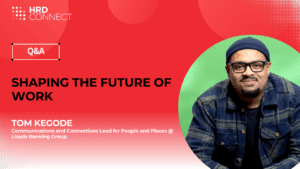Mastering the art of communication in 2021
- 6 Min Read
Internal communication in the workplace has always been key, but with today’s distributed ways of working, it has never been more critical. 2020 has been a trial by fire, but in 2021, it’s time for for leaders to master the art.
- Author: Sam Alberti
- Date published: Dec 14, 2020
- Categories

Communication: a broad, all-encompassing term. Not simply a skill or an action, but rather, one of the core tenets of human existence, and arguably the primary building block upon which we evolve, innovate, and form relationships.
Albert Mehrabian’s semi-legendary 1967 study goes some way towards demonstrating this. A mainstay of the psychological and business canon, and commonly dubbed as the ‘7-33-55 rule’, the study indicates that just 7% of human communication is verbally-charged. Rather, it posits that 38% is formed of ‘tonality’, with ‘body language’ comprising the final 55%.
Perhaps a key indication of the multidimensional nature of communication, and how challenging it can be to master on an organizational level.
But challenging as it may already be, 2020’s highly distributed, COVID-induced ways of working have compounded this difficulty. Whether it’s the dissemination of company-wide information, the manner in which leaders interact with their teams, or the delivery style of meetings, there has never been a more appropriate time for an organization to refine its communication strategy.
Communication in 2020
In a corporate climate where co-located working feels as though it’s verging on archaic, there has emerged a newfound imperative for organizations to refine, and in some instances exaggerate communication strategy.
Not only does this apply to areas such as delegation and work-based discussion, but perhaps more pertinently, the manner in which the company’s senior leadership digests and distributes information regarding the seemingly unerring changes in the world of work at present.
But even under ordinary circumstances, communication lies at the very heart of how a company operates, bearing the potential to influence every aspect of it. Author, disruption thinker and HRD Thought Leader Terence Mauri gave his thoughts.
“Internal comms has never been more important,” he said. “Blurring of industry lines, economic and geopolitical uncertainty, disruptive tech such as AI and automation, shrinking of company and product lines and, of course, a global pandemic has put tremendous pressure on this.
“The pandemic has accelerated a number of trends. What this means is that internal comms strategy must address knowable and unknowables in the operating environment and use trust as its north star for making all ethical, moral, product and service decisions.”
The potential impact of this is undoubtedly far-reaching and practically immeasurable. From the manner in which 121 meetings between managers and employees are conducted, to the way in which stakeholders, boards of directors and senior leadership teams delegate to middle management, to the dissemination of new initiatives and key government updates to the workforce at large; this forms a major and crucial part of an organization’s stability, and ultimately, its lifespan.
In general, an impact on job satisfaction, engagement, productivity, retention, and profitability can be expected to some degree.
How communication can be revamped in 2021
Naturally, and as is the case with many of the highly-disrupted areas of business this year, organizations will now be looking to rethink the manner in which internal communications are approached.
One such organization is Stanley Black & Decker, which has undergone some fundamental shifts in the way that information is distributed among its people. Paul Hevesy, the company’s HR Director, offered some further detail, explaining that work transformation has formed the basis of the approach.
“What we found is people are finishing their day, and they don’t feel accomplished,” he said. “They feel burdened with too many things and not enough time to get them done, and they spend the majority of their day in meetings of some kind. And a lot of the time, the feedback is: ‘I don’t know why I’m in this meeting; I never say anything, and it’s recurring every week'”
This is a scenario that will be familiar to many (particularly since making the transition to remote working), and can often prove to be damaging when it comes to productivity levels.
Hevesy goes on to explain how this can be remedied, largely focusing on the subject of meeting more effectively, and establishing a ‘meeting culture’.
He said: “Just be very intentional around prioritization, because when everything’s a priority, nothing is. When you move meetings from 60 minutes to 45 minutes, you start to give people time back, and you also encourage people to think about which meetings they actually need to be in. Part of our culture is to encourage people to raise their hand and say ‘hey, do I need to be in this meeting?’.
“And then the other big thing is, if you’re a leader in an organization where most of your meetings are information-only, start thinking about those differently. Really challenge people on information-sharing. solving a problem or making a decision, and you’re just sharing information, can you do it differently, and cancel that meeting and give people time back?”
Communication, in a more holistic sense, is something else that Hevesy comes on to, providing some guidance on how the distribution of information can be streamlined across an organization.
He said: “If you’re not creative and proactive with your communication as a leader, people are going to stop listening. The big piece is starting with your key message. Normally, what you do is have 15 or 20 slides, and the last two slides would be ‘here’s what I think we should do’. Now, I’m saying, instead of half an hour, set it for 20 minutes and start with your key message, and if people feel like they need more, you can walk through that quickly.
“It saves time, it gets people focused, you get in and you get out. If you have a culture where people treat meetings like work, then the business simply isn’t going to move forward.”
Offering some final pieces of actionable guidance, Hevesy said: “Look at your calendar for the next two weeks, look at the meetings you’ve set up, and look at the meetings you’re invited to. The meetings you’ve set up, shorten them and put an agenda on it. Then the meetings that you’re in, identify the ones where you don’t say anything, and consider raising your hand and saying ‘hey, can I duck out of this meeting moving forward?’
“Those are two super practical things, and you can do them today.”










